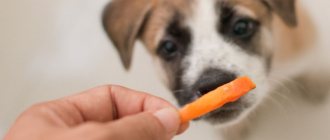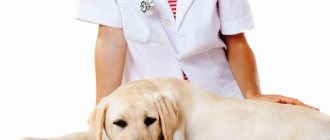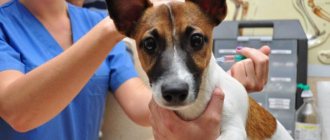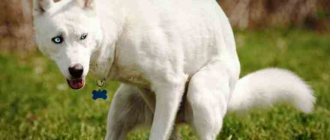Anyone who has owned a dog knows that they have an inexplicable capacity for unconditional love that can only be seen between a man and his faithful friend. When we are upset or feeling down, a gentle touch of a wet nose and a lick of the hand can put us back in good spirits. A rush to the door to greet the owner from work and a dancing tail from side to side is a clear sign of the strength of the human-dog bond. But why do dogs love us so much?
Genetic research
In an attempt to explain how dogs evolved from wolves into the miniature lapdogs we know and love, scientists have identified several genetic mutations that may be behind their friendly personalities. Somehow dogs evolved to love people. Roughly speaking, tens of thousands of years ago, wolves likely began stalking human hunter-gatherers to feed on the leftover meat from human kills. Scientists think it's possible that the friendlier wolves were given extra scraps and the wilder, scarier wolves were killed, and over time, this friendly group of wolves eventually evolved into dogs. However, the genetic blueprint underlying this personality change still remains a mystery.
Evolutionary geneticists from Princeton and Oregon State University have assembled a team of scientists to find out what distinguishes dogs from wolves. Using a combination of genetic sequencing and behavioral tests, they identified a pair of genetic differences that seem to be traceable to dogs' friendliness. The scientists began by testing how 18 dogs and 10 wolves behave around people.
For one test, dogs and wolves were tasked with retrieving food from a puzzle box, either in front of a person or alone. The wolves remained more focused and outperformed the dogs in challenges, even when a human was nearby. Dogs, on the other hand, preferred to spend more time near a person than near a box with puzzles. Another test measured how many times a dog or wolf was close to a person sitting nearby. In general, dogs spent much more time around humans than wolves.
In an earlier study, scientists identified a gene that mutated more often in dogs than in wolves. Perhaps this is due to domestication. This gene also corresponds to a gene in people born with a condition called Williams syndrome, or WBS. People with WBS tend to be particularly social and friendly, leading researchers to suspect that these genes may be important for friendliness in both humans and dogs.
So the team found several mutations that appear to be linked to dogs' sweet nature: two of them may disrupt the functions of the GTF2I and GTF2IRD1 genes, which make proteins responsible for turning other genes on and off. Animals with these mutations appear to pay more attention to people than those without them. Earlier work showed that deleting these genes in mice makes the little rodents much friendlier.
We also recommend reading:
Pet habits: what signals should you pay attention to? Top 7 Dogs That Are Great for Children Stubborn Personality: Dogs That Are Difficult to Train Ways to Correct Malocclusion in Puppies
Scientists don't claim to have found the mutation that controls sociability. There are many genes in the genome that likely contribute to dogs' friendly behavior, and the team only examined a small portion of them. Moreover, genes are not deterministic. This means that raising a dog in a loving environment or with complete indifference can determine how friendly the dog will be towards humans.
Confidential look
Professor of cognitive neuroscience Dr. Brian Hair, in one of his interviews, put it very interestingly - when your dog looks intently into your eyes, it is as if he is “hugging you with his gaze.”
This doesn't mean you have to stare into someone else's dog's eyes. Direct eye contact can still be considered challenging or threatening to the dog in many situations. But with your beloved friend, whom you trust and he trusts you, you can look tenderly into his eyes when you are calmly resting. Dogs have excellent hearing, so you can also quietly say something to him and gently stroke him; your tailed friend will clearly appreciate such a sign of attention. Also, according to Hare, such joyful moments stimulate the production of oxytocin in both the dog and human brain, and this is the same hormone that bonds mother and child.
Is love really that important?
Dogs are the only species that, like a child, runs to its owner when he is scared, worried or simply happy to see us. It is also the only animal that actively seeks eye contact with people and genuinely wants to be with us.
Earlier research has shown that eye-to-eye contact between a dog and a human can increase levels of oxytocin (a hormone involved in social bonding) in both humans and dogs. Pets give people so much in terms of love and emotional support. Simply petting a dog can lower a person's blood pressure and stress hormone levels. Perhaps our touch can also have the same therapeutic effect on a dog, especially if they are feeling lonely.
Scientists also discovered that the scent of dog owners actually causes them to activate in the "reward center" of their brain, called the caudate nucleus. This means that dogs have the ability to distinguish between their owner and a huge number of other olfactory stimuli around them.
The broader bond between humans and dogs has strengthened over time—about 30,000 years to be exact—so every year scientists are finding more and more explanations for this deep bond that developed so long ago between dog and human.
How to show your dog your love
12/16/2020 Drozd Nikolaevich Animals When a beloved owner is nearby, the dog doesn’t need anything more. She is the happiest, she feels calm and comfortable next to her loved one. Love in a dog's understanding is affection and trust.
How do puppies show their love? They try to cuddle close to the owner: being apart for at least a few hours, when they meet, they lick their hands and try to lick their face. They pee out of happiness, fall on their backs and expose their tummy for caresses. As the pet grows up, its emotions become slightly restrained, but do not go away.
RELATIONSHIP OF DOG TO HUMAN
It is difficult to say what a dog thinks and feels. They are subject only to facial expressions, gestures and sounds.
This is what can be considered a manifestation of love from a dog to a person.
- The dog tries to lick your face. It’s as if she’s trying to say, “I’ve missed you so much all day, let me kiss you.” If you are against such tenderness, you can not allow it, but under no circumstances scold or punish the dog, otherwise mental trauma cannot be avoided.
- Caring when you're in pain. If you get hit or scratched, the dog will try to ease your pain.
- The desire to share a favorite toy or treat. By bringing you something of his own, the dog is trying to attract your attention and makes it clear - “I care about you, you are dear to me.” Be sure to praise your pet for this.
- The desire to cuddle after eating should be regarded as gratitude and joy, this is a sign of complete trust in your person.
- Co-sleeping. Here, of course, all owners are divided into two camps: those who are “for” and those who are “against”. Whether you let a dog into your bed or not is entirely your decision. But we can say with confidence that a dog sleeping next to its owner is a manifestation of the purest canine love. Those dogs who are not allowed into the bed try to sleep next to the bed, as close as possible to their loved one. This is how the dog makes it clear: “I’m nearby, you can sleep peacefully, I’m protecting you.”
- Surveillance. The dog tries to constantly keep you in sight, you go to the kitchen - she follows you, you go to the bathroom - she follows you like a tail. This is an indicator of strong attachment.
HOW TO SHOW YOUR LOVE TO YOUR DOG
Surely your dog will appreciate a quiet word of affection or soft stroking accompanied by eye contact. In the dog's body, with such trusting views, the hormone oxytocin is produced, which strengthens the bond between the owner and the dog.
Embrace. Few people like to hug intrusively and tightly, so when showing your emotions, do not overdo it. Show your love by gently pressing your body against your pet. A dog can show a desire to hug by placing its muzzle on its knees or legs, this is a kind of hug.
Possibility of co-sleeping. Sleeping together next to the owner indicates that the pet certainly trusts its owner. You don't have to sleep in the same bed as your dog. You can show your love by placing a dog bed in your bedroom or nearby, near the bed.
To summarize: not only be kind and caring, control your voice intonation, do not shout, speak smoothly and gently, putting all the love into your voice. And you will have mutual understanding.
Source: veterinarian.hozvo.ru
animals
Do dogs have feelings?
Emotions consist primarily of neural, chemical, and hormonal responses that predispose animals to be distracted in certain ways by certain stimuli, such as experiencing joy at the sight of their owner. Feelings are also related to the limbic system, but they involve conscious evaluation and an element of spontaneity. It is impossible to think of feelings as emotions because feelings require the conscious reflection of emotions and our response to them. Feelings are a person's subjective reaction and how they deal with their emotions.
The main problem we face today when researching canine sensitivity stems from the limitations of our understanding of their cognitive systems. We don't yet have enough evidence to definitively say that dogs can reflect on the joy they feel when you come home, rather than just experience it. At present, science and technology have not yet allowed us to demonstrate that dogs have this complex level of thinking and cognition.
Although we know that animals have emotions, we cannot scientifically say that they have the feelings that humans have. The same feeling of guilt will require dogs to reflect on what they did and understand why they feel bad.











